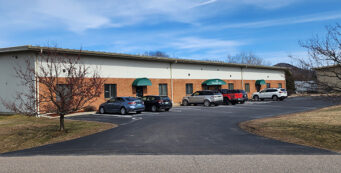Considering the growing demand for industrial real estate, golf courses are popular targets for conversion to warehouse and distribution centers.
With the appetite for industrial warehouse and distribution space continuing to grow, more developers have begun to eye — and buy — golf courses for conversion to industrial parks. These large parcels of land, many near highways, can be attractive sites for the facilities required by e-commerce and other users. Even Amazon, which used to shy away from golf courses, has begun to develop these manicured green spaces into warehouse and distribution centers.
An oversupply of golf courses — and U.S. consumers’ growing preference for online shopping and close-to-immediate delivery — are making these expansive acreages, once reserved for an afternoon of birdies and bogies, too attractive to pass up. While not welcome by all communities, these conversions for industrial uses are likely to increase in the future.
An Increasing Supply
Golf as a participation sport has been in decline in the United States for about 15 years. Today, about 5 million fewer individuals play compared to 2005, a drop from 30 million to 24.3 million, according to the National Golf Foundation.
The main reason for this decline is that young people have not taken to golf the way their parents and grandparents did, finding it time-intensive and expensive. Despite a bump in interest in golf during the first year of the pandemic because it offered people a way to socialize outdoors safely, that interest seems to have dropped off again as other activities became available. Rounds played in July 2021 were down 3.9 percent nationwide from July 2020, according to the NGF.
With demand falling, it’s clear the U.S. overbuilt golf courses, a lot of which occurred during the late 1990s and early 2000s, when Tiger Woods was popularizing the sport. Leading the charge were municipal park districts and residential golf community developers, especially in the suburbs, where too many golf courses were built too close to each other without thought of market oversaturation. With fewer players, many of these suburban courses were particularly vulnerable, leading to the nearly two-decades’-long shakeout. In all, about 2,500 courses have closed since 2005, according to the Internet Golf Database.

Buying, running, and maintaining a golf course is expensive; margins are slim; and operators need to be disciplined about pricing, expenses, and maintenance. According to the NGF, one-third of public golf facilities did not make enough revenue in 2019 to cover all on-site expenses. Private and municipal courses have similarly struggled.
Industrial’s Booming Demand
As golf courses are struggling — and in many cases, failing — e-commerce is propelling the need for warehouse and distribution facilities. With more of us buying online during the pandemic and increasingly expecting next-day or same-day delivery, e-commerce providers are all desperately seeking large, well-located warehouse and distribution centers near railroads, expressways, and airports, with proximity to population centers. Demand for warehouse space hit 350 million square feet in the top 22 markets in 2020, according to CBRE, up 20 percent from 2019. Industrial vacancy nationally was 4.3 percent in 3Q2021, according to JLL, and rents increased to $6.76 per sf, up 7.1 percent from a year earlier.
Users want large, modern, newly constructed facilities with all the bells and whistles, like 36-foot clear heights and lots of trailer and car parking. And while there is a need for some smaller last-mile facilities within cities, many users need big-box facilities that start at a minimum of 500,000 sf and reach 1 million sf or larger. That means industrial developers and contractors need to build facilities on large sites, typically in suburban or exurban locations.
The more the demand accelerates, the better underutilized golf courses look. Before the current jump in industrial demand, golf courses were not necessarily considered good sites for industrial development. The locations are complex, often with environmental and conservation issues — many have significant wetland/floodplain restrictions which create headaches for site planning. Rezoning is typically the largest hurdle to overcome for industrial developers. For instance, the three golf courses in Orland Park, Ill., are Silver Lakes (E-1 estate residential), White Mountain (BIZ general business) and Crystal Tree (R-1 & R-3 residential). To change the zoning to an approved commercial use, developers will have to go through zoning board and village board approval, each requiring a process with public hearing meetings — and that means being prepared to persuade some angry residents who do not want warehouses in their neighborhoods.
The more the demand accelerates, the better underutilized golf courses look. Before the current jump in industrial demand, golf courses were not necessarily considered good sites for industrial development.
Amazon, for example, used to shy away from golf courses because they required too much extra effort to develop. But as the need for industrial space has exploded, users and developers are willing to take a second look. Amazon now has developed several courses for warehouse and distribution facilities, including the former Skyland Pines Golf Course, an 18-hole course, banquet center, and driving range in Canton, Ohio, off U.S. Route 62 and Columbus Road, where Amazon will have a 1 million-sf warehouse. Another example is a 634,00-sf fulfillment center being built on the former Pine Lakes Golf Course in Alcoa, Tenn.
Courses near my firm in suburban Chicago that are being sold or have been sold for development include the golf course at Pheasant Run Resort in St. Charles, Ill., about 40 miles west of Chicago, and Lansing Country Club in Lansing, Ill. Several other Chicago-area courses are now being marketed specifically for residential redevelopment, including Silver Lake Country Club in Orland Park and Big Run Golf Club in Lockport.
Without question, while some municipalities welcome the jobs and taxes that warehouses bring, not all communities are welcoming golf course conversions with open arms. For example, in Illinois, the Village of Homewood has been locked in a years-long battle around the fate of the Calumet Country Club Golf Course, established in 1901 and annexed to Homewood in 1980. The course had been financially troubled for many years before being sold to a developer, who wants to use it for an 800,000-sf distribution facility. Village officials and angry residents have locked horns at many contentious meetings, and the future of the site is currently unclear. Industrial sites introduce truck traffic, noise, and pollution, so not everyone is willing to trade that for same-day deliveries. But the promise of job opportunities and greater tax revenue for public improvements can be hard to turn down for cash-strapped municipalities.
Consumers are predicted to increase their online shopping habits, and retailers who want to compete need to match the delivery speeds of Amazon, Walmart, and Target, so the need for warehouse and distribution space will continue to grow. More places will see the fenced-in 175-acre green space in their community — once a spot for a day on the links — give way to big-box warehouses that are the stopping points for the groceries, electronics, and furniture that customers want at ever-increasing speeds.








